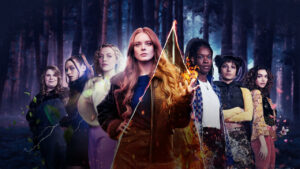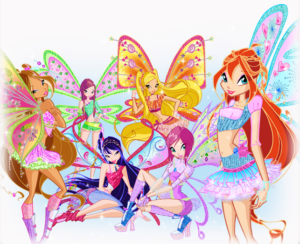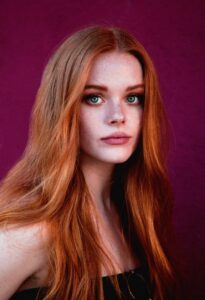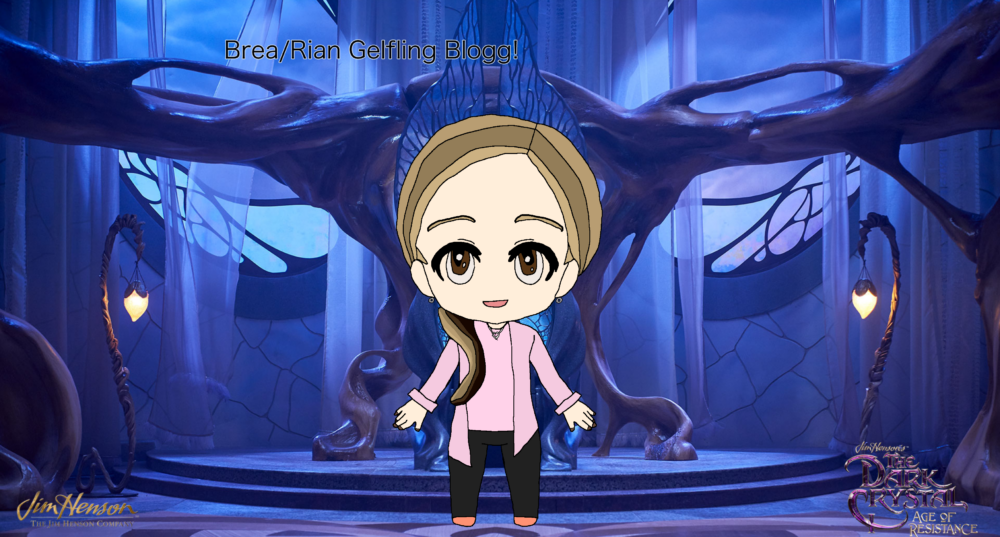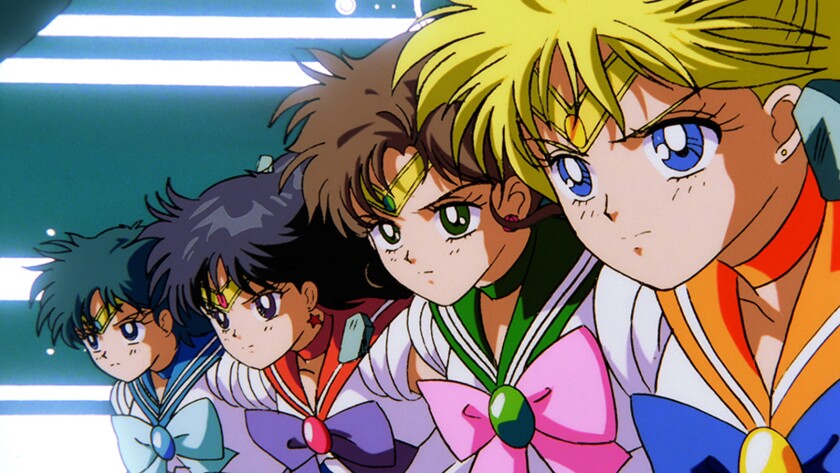Winx Club Serien 2004.
From Wikipedia, the free encyclopedia
Winx Club is an Italian-American animated series co-produced by Rainbow SpA and Nickelodeon. It was created by Iginio Straffi. The show is set in a magical universe that is inhabited by fairies, witches, and other mythical creatures. The main character is a fairy warrior named Bloom, who enrolls at Alfea College to train and hone her skills. The series uses a serial format that has an ongoing storyline, with individual story arcs comprising each season. It premiered on 28 January 2004, becoming a ratings success in Italy and on Nickelodeon networks internationally.
Iginio Straffi initially outlined the show’s plot to last three seasons. He chose to continue the story for a fourth season in 2009. Around this time, Winx Club’s popularity attracted the attention of the American media company Viacom, owner of Nickelodeon. Viacom purchased 30% of the show’s animation studio, Rainbow SpA, and Nickelodeon began producing a revival series. Production on the fifth, sixth, and seventh seasons was divided between Rainbow and Nickelodeon Animation Studio. To attract an American audience, Viacom assembled a voice cast of Nickelodeon actors (including Elizabeth Gillies and Ariana Grande), invested US$100 million in advertising for the series, and inducted Winx Club into Nickelodeon’s franchise of Nicktoons.
Beginning in 2010, episodes of Winx Club have been jointly written with Nickelodeon’s American team. Nickelodeon’s writers aim to make the series multicultural and appealing toward viewers from different countries. In 2019, Straffi commented on his near-decade of collaboration with Nickelodeon, saying that ”the know-how of Rainbow and the know-how of Nickelodeon are very complementary; the sensibilities of the Americans, with our European touch.” The continued partnership between Rainbow and Nickelodeon on Winx Club has led to the development of more co-productions, including Club 57 in 2019, on which much of Winx Club’s staff worked.
The series was subject to budget cuts in 2014, during its seventh season. The 3D computer-generated segments and Hollywood voice actors were deemed too costly to keep using. The seventh season eventually premiered on Nickelodeon’s worldwide channels in 2015. After a four-year hiatus, an eighth season premiered in 2019. At Straffi’s decision, this season was retooled for a preschool target audience. Most of the show’s longtime crew members were not called back to work on season 8. Straffi stepped away from the series at this time, shifting his focus to Club 57 and other live-action projects. A live-action adaptation of Winx Club for young adults, titled Fate: The Winx Saga, was announced in 2018.
The main characters of Winx Club are girls who can transform into fairy warriors.
Main article: List of Winx Club characters
The series follows the adventures of a group of girls known as the Winx, students (and later graduates) at the Alfea College for Fairies, who turn into fairies to fight villains. The team is made up of Bloom, the red-haired leader with flame-based powers; Stella, the fairy of the Sun; Flora, the fairy of nature; Tecna, the fairy of technology; Musa, the fairy of music; and Aisha, the fairy of waves. Roxy, the fairy of animals, occasionally joins the Winx and all three of the show’s production companies refer to her as the Winx Club’s seventh member. The main male characters are called the Specialists, a group of students and later graduates of the Red Fountain school who are romantically involved with the Winx fairies. They include Bloom’s fiance Sky; Stella’s fiance Brandon; Flora’s boyfriend Helia; Tecna’s boyfriend Timmy; and Musa’s boyfriend Riven. Unlike their female counterparts, the Specialists do not have magical powers and instead train how to fight using laser weapons. The Winx and Specialists’ most common adversaries are a trio of witches named the Trix: Icy, Darcy, and Stormy, all former students of the Cloud Tower school.
Winx Club is set in a vast universe that has several dimensions. Most episodes take place in the Magic Dimension, which is closed off to ordinary people and inhabited by creatures from European mythology like fairies, witches, and monsters. The capital of this world is the city of Magix—which is located on the planet of the same name—where the three main magic schools are situated. The other planets of the Magic Dimension include Bloom’s home planet Domino, Stella’s home planet Solaria, Flora’s home planet Linphea, Tecna’s home planet Zenith, Musa’s home planet Melody, and Aisha’s home planet Andros.Some episodes take place on Earth, Roxy’s home planet and where Bloom spent her childhood.
History- Concept and creation – During the 1990s, comic artist Iginio Straffi noticed that action cartoons were mostly focused on male heroes; at the time, he felt that the ”cartoon world was devoid of female characters.” Straffi hoped to introduce an alternative show with a female lead aged 16 to 18, as he was interested in ”exploring the psychological side” of the transition to adulthood. He decided to develop a pilot centred on the conflict between two rival colleges; one for fairies and another for witches. Straffi compared his original premise to ”a sort of ’Oxford–Cambridge rivalry’ in a magical dimension”. In expanding the concept, Iginio Straffi drew his inspiration from Japanese manga and the comics of Sergio Bonelli, a comic writer for whom Straffi had worked.
Straffi’s pilot, which was titled ”Magic Bloom,” featured the original five Winx members in attires similar to those of traditional European fairies. It was produced during a twelve-month development period that included animation tests, character studies, and market surveys. The animation attracted the interest of Rai Fiction, which paid for 25% of the production cost in exchange for Italian broadcast rights and a share of the series’ revenue over 15 years. After holding test screenings of the pilot, however, Straffi was unhappy with the audience’s unenthusiastic reaction to the characters’ outdated clothing style and stated that the pilot did not satisfy him. In a 2016 interview, Straffi said the end result was unoriginal and ”looked like just another Japanese-style cartoon … but nothing like [the modern] Winx ”. He likened his feelings about the pilot to an ”existential crisis” and chose to scrap the entire test animation despite an investment of over €100,000 in the completed pilot.
To rework the concept, Straffi’s Rainbow team hired Italian fashion designers, including some from Dolce & Gabbana and Prada, to restyle the show and give the characters a more modern appearance. The crew changed the show’s color palette, replacing the pilot’s colour scheme with a brighter collection of hues, and adjusted the skin tone of one of the protagonists to look ”more Latin” in an attempt to add diversity to the show. Production of the restyled series began by 2002, and Rainbow estimated the episodes would be delivered to distributors by late 2003. The new name of the series (”Winx”) was derived from the English word ”wings,” and the ”x” was intended to evoke the shape and sound of wings. Straffi’s aim was to appeal to both genders, including action sequences and displays of power designed for male viewers and fashion elements for female viewers.[ At the October 2003 MIPCOM event, Rainbow screened the show’s first episode to international companies. The first season had its world premiere on Italian television channel Rai 2 on 28 January 2004.
From the beginning of development, Iginio Straffi planned an overarching plot that would conclude after 78 episodes. Straffi stated that the Winx saga ”would not last forever” in 2007, and he intended the first feature film (Winx Club: The Secret of the Lost Kingdom) to resolve any plot points remaining from the third season finale. In 2008, Straffi decided to extend the series, citing its increasing popularity.
Nickelodeon revival – In February 2011, the American company Viacom (owner of Nickelodeon) became a co-owner of the Rainbow studio; Viacom bought 30% of Rainbow for 62 million euros (US$83 million). Viacom originally planned to buy out the entire Rainbow studio but wanted to keep Iginio Straffi at the helm, leaving Straffi with 70%. Coinciding with the purchase, Viacom announced that Nickelodeon would team up with the original creator on an ”all-new Winx Club” revival series. Viacom financed and staffed the revived series, dividing production between Viacom’s Nickelodeon Animation Studio in the United States and Rainbow in Italy.
The revived series began with four special episodes that summarize the first two seasons of the original show, followed by the fifth, sixth, and seventh seasons. As the production team was divided between two countries, Nickelodeon released a statement commenting on how Winx Club was an unusual production for the company: ”it’s not our usual practice to co-produce cartoons; we make them by ourselves. But we strongly believe in Winx.”Along with another brand revival (Teenage Mutant Ninja Turtles), Winx Club was officially inducted into Nickelodeon’s franchise of Nicktoons, a brand that encompasses original animated productions created for the network. On each episode of the revived series, Nickelodeon approved scripts and all phases of animation. Nickelodeon brought on some of its long-time staff members, such as creative consultant Janice Burgess, and writers Adam Peltzman and Carin Greenberg.
On 7 April 2014, Rainbow and Nickelodeon announced their continuing partnership on the seventh season of Winx Club, with a planned premiere date of 2015. Straffi said of the season: ”It will be a privilege to partner once more with Nickelodeon on this.”During this season’s production, Rainbow was undergoing a multimillion-euro financial loss due to the box office failure of its film Gladiators of Rome. This made them cut costs on Winx Club, its most expensive show. The CGI-animated segments and California voice cast from the previous two seasons were deemed too costly to continue using for season 7. As with the previous two seasons, the copyright to season 7 is co-owned by Rainbow and Viacom. The first episode aired on 22 June 2015, on Nickelodeon in Asia,followed by its broadcast on 21 September 2015 on Rai Gulp in Italy.
The president of Nickelodeon International, Pierluigi Gazzolo, was responsible for arranging the co-production partnership and became a member of Rainbow’s board of directors (a role he continues to serve in, as of November 2019). In addition to financing the television series, Viacom provided the resources necessary to produce a third Winx film. In 2019, Iginio Straffi commented on the two studios’ near-decade of continued work together, saying that ”the know-how of Rainbow and the know-how of Nickelodeon are very complementary; the sensibilities of the Americans, with our European touch.” Winx Club opened the opportunity for Nickelodeon and Rainbow to collaborate on additional co-productions together, including various pilots from 2014 onward and Club 57 in 2019.
Retooled eighth season- The eighth season of the series was not produced immediately after the seventh. It followed a multiple-year hiatus and was not made as a direct continuation of the previous season. At Iginio Straffi’s decision, Season 8 was heavily retooled to appeal to a preschool target audience.
For season 8, Rainbow’s creative team restyled the characters to appear younger, hoping to increase the appeal toward preschoolers. The plot lines were simplified so that they could be understood by a younger audience. Most of the show’s longtime crew members were not called back to work on this season, including art director Simone Borselli, who had designed the series’ characters from season 1 to 7, and singer Elisa Rosselli, who had performed a majority of the songs. In another change from previous seasons, Nickelodeon’s American team served as consultants rather than directly overseeing the episodes; at the time, Nickelodeon was instead working with Rainbow on a new co-production, Club 57. Season 8 was also the first-ever season without the involvement of Rai Fiction.
Iginio Straffi made the decision to shift the show’s intended audience after years of gradually aiming toward a younger demographic. In a 2019 interview, Straffi explained that decreasing viewership from older viewers and an increased audience of young children made this change a necessity. He elaborated that ”the fans of the previous Winx Club say on social media that the new seasons are childish, but they don’t know that we had to do that.” Straffi stepped away from the series at this time and did not oversee season 8’s production like he had for the previous installments. He instead shifted his focus to live-action projects aimed at older audiences: Nickelodeon’s Club 57 and Fate: The Winx Saga. Straffi explained that ”the things we had to tone down [in season 8] have been emphasized in the live action–the relationships, the fights, the love stories.” He added that he hopes that Fate will satisfy the ”20-year-olds who still like to watch Winx.”
Production,Design- The series’ visuals are a mixture of Japanese anime and European elements, which Iginio Straffi calls ”the trademark Rainbow style”. The main characters’ final designs are based on Straffi’s original sketches, which were modelled on celebrities popular at the turn of the 21st century. In a 2011 interview with IO Donna, Straffi stated that Britney Spears served as the basis for Bloom, Cameron Diaz for Stella, Jennifer Lopez for Flora, Pink for Tecna, Lucy Liu for Musa, and Beyoncé for Aisha. This approach was part of Straffi’s aim for the fairies to represent ”the women of today” and look much more modern than classic examples like la Fata Turchina. The three Trix witches were also designed to appear ”beautiful and fashionable” to counter the stereotype of ugly witches.
A team of specialized artists designs the characters’ expressions and outfits for each season. About 20 tables of expressions and positions from all angles are drawn for each character. The designers start to develop characters’ costumes by creating collages from magazine clippings of recent fashion trends. Using these as references, they draw multiple outfits for each character. Simone Borselli, the series’ art director, designed most of the characters’ early-season clothing despite lacking a background in fashion design. When asked by an interviewer where his fashion intuition came from, Borselli responded, ”From being gay.”
The first stage in the production of an episode is developing its script, a process that can last 5–6 months. When the series began production, the writers were based entirely in Italy. After Viacom became a co-owner of Rainbow in 2011, Rainbow’s group of 30 writers began collaborating with teams in both Italy and the United States. The international coordination, which has continued through 2019, intends to make scenarios depicted in the program multicultural and accessible to viewers from different countries.Episodes are written with two stories in mind: a longer narrative arc that lasts for tens of episodes and a subplot that concludes at the end of the 22-minute runtime. This episode structure was modelled on those of teen dramas and American comics. Themes written into the series include romance, the acquisition of maturity upon reaching adulthood, and (in the fifth season) nature conservation.
After the script and character designs have been approved, the screenplay is passed onto a group of storyboard artists. For each 22-minute episode, the artists prepare 450 pages of storyboards for each 22-minute episode, which are used to assemble an animatic. At this stage, dialogue and music are added to determine the length of each scene. In the original series (seasons 1–4), the characters’ mouths were animated to match the Italian voice actors’ lines; in the revived series, the mouth movements were matched to the English scripts. Episodes are worked on concurrently because each requires around two years of work to complete.
At the beginning of the first season, the ten-person production team worked at Rainbow’s original headquarters in Recanati. In 2006, Straffi opened a second studio in Rome for computer-animated projects. During the fifth and sixth seasons, 3D CGI sequences were incorporated into the series for the first time, animated at the studio in Rome. According to the Rainbow CGI animators, the animation of the characters’ hair in underwater scenes was particularly difficult, and it was animated separately from the characters.
Cast:- In Italy, the series’ voice actors include Letizia Ciampa (Bloom), Perla Liberatori (Stella), Ilaria Latini (Flora), Domitilla D’Amico (Tecna), Gemma Donati (Musa), Laura Lenghi (Aisha), and Debora Magnaghi (Roxy). According to Ilaria Latini, the characters were cast before any character designs were finalized and the actors were shown black-and-white sketches of their roles. The actors record their lines in Rome. Seasons 1–4 were animated to match the Italian voices. Since season 5, the animation has been synchronized to match the English scripts.
The 2011 specials introduced a new cast of Hollywood voice actors, who recorded their lines at the Atlas Oceanic studio in Burbank, California. For this cast, Viacom hired popular actors whose names were advertised on-air to attract American viewers; these stars included Ariana Grande as Diaspro, Elizabeth Gillies as Daphne, Keke Palmer as Aisha, Matt Shively as Sky, and Daniella Monet as Mitzi. These actors provided voices for the first two Winx films and seasons three through six. In 2014, Viacom relocated the series’ English cast to DuArt in New York City; this was done as a cost-cutting and time-saving measure, since Rainbow was undergoing a significant financial loss at the time. Despite the change in voice actors, the series’ animation continued to be matched to Nickelodeon and Rainbow’s English scripts for the seventh season.
Music- According to Iginio Straffi, music plays a crucial role in the success of the series. Original pop songs in the ”style of Britney Spears and Beyoncé” have been recorded in about 40 languages for the show. Songs are usually drafted in English; Italian lyrics are written after Rainbow has approved the English versions. Frequent composers for the program include Michele Bettali, Stefano Carrara, Fabrizio Castania, and Maurizio D’Aniello. Music is recorded in Milan and Rome, and each song takes between five and twelve months to complete. One of Nickelodeon’s composers, Emmy and Grammy Award recipient Peter Zizzo, joined the team during Nickelodeon’s joint production of the fifth season. His music is featured in the fifth, sixth, and seventh seasons; he also composed the stand-alone single ”We Are Believix” for the show. The single was accompanied by a Nickelodeon live-action music video that was performed by Elizabeth Gillies and was released on iTunes. Six compilation albums based on the show’s music have been released; some include songs that do not appear in the television series.
Many of the show’s tracks are performed by Italian singer Elisa Rosselli. She was selected during the production of the first Winx film, as Iginio Straffi was seeking a writer and singer for the movie’s soundtrack. Straffi looked to Sony Music’s archive for inspiration and enjoyed three of Rosselli’s songs that were co-produced with Maurizio D’Aniello. After working together on the film, Rosselli continued to produce music for the show (usually in collaboration with D’Aniello or Peter Zizzo) until its seventh season.
Winx Club is an Italian-American[a] animated television series co-produced by Rainbow SpA and Nickelodeon, which are both part of ViacomCBS. The show was created by Iginio Straffi. It follows a group of fairy warriors called the Winx as they enroll in Alfea College and learn to fight mythical villains.
From the beginning of the show’s development, Iginio Straffi planned an overarching plot that would conclude after three seasons. A feature-length film followed the third season, intended to wrap up the series’ plot as the fairies graduate from Alfea College. In 2008, Straffi made the decision to extend the original series with a fourth season, citing its increasing popularity. During the production of the fourth season, the American company Viacom (owner of Nickelodeon) engaged in a ”long courtship” with the Rainbow studio. Viacom became a co-owner of Rainbow to produce their own episodes of Winx Club.
In 2010, Viacom announced that ”Nickelodeon is teaming up with the original creator to present an all-new Winx Club.” Viacom’s Nickelodeon Animation Studio started production on a revived series, in which the Winx are once again students at Alfea, as they were before their graduation in the original show. The Nickelodeon revival began with four television specials that summarize the first two seasons of the original series. After the specials, Viacom’s brand-new fifth, sixth, and seventh seasons were broadcast on Nickelodeon networks worldwide ahead of the Italian broadcasts.
Winx Club employs a serial format, with each episode contributing to the overall storyline. Episodes are written with two stories in mind: the longer narrative arc that lasts for tens of episodes and a subplot which concludes at the end of the 22-minute runtime. This episode structure was modeled on those of teen dramas and American comics.
When Iginio Straffi began developing Winx Club at the Rainbow studio, he outlined the plot to last three seasons (78 episodes). In 2007, Straffi explained that ”the Winx saga was planned in detail from the beginning. And it will not last forever.” The third season follows the fairies’ last year at Alfea College, during which they earn their final fairy form, Enchantix. In 2008, Iginio Straffi chose to continue the story for a fourth season. During the fourth season’s development, Viacom began discussions to become a co-owner of the Rainbow studio and produce a revival series, which began with a retelling of the first two original seasons.
Main article: Winx Club § Concept and creation
The pilot episode for the series, then under the working title Magic Bloom, featured the original five Winx members in attires similar to those of traditional European fairies. It was produced over a period of twelve months and was test-screened in 2002.Upon its completion, Straffi was unsatisfied with the pilot and doubted that it would succeed if aired. In a 2016 interview, Straffi recalled that it ”looked like just another Japanese-style cartoon … but nothing like [the modern] Winx.” Straffi’s team heavily reworked the pilot’s visual style before starting work on a full season, leaving the original pilot unaired. Portions of the pilot were presented at the Lucca Comics & Games convention in 2018.
Main article: Winx Club (season 1)
Main article: Winx Club (season 2)
Main article: Winx Club (season 3)
Main article: Winx Club (season 4)
After Viacom became a co-owner of the Rainbow studio in 2011, new seasons entered production at Viacom’s Nickelodeon Animation Studio and Rainbow. In this revamped series, the Winx are once again students at Alfea, as they were before their graduation in the original show. The revival began with four specials that retell the original first and second seasons. Nickelodeon’s American writers aimed to make the series multicultural and appealing toward viewers from different countries. In 2019, Straffi commented on his near-decade of collaboration with Nickelodeon, saying that ”the know-how of Rainbow and the know-how of Nickelodeon are very complementary; the sensibilities of the Americans, with our European touch.”
Main article: Winx Club (season 5)
Main article: Winx Club (season 6)
Main article: Winx Club (season 7)
Main article: Winx Club (season 8)
Main article: Winx Club: The Secret of the Lost Kingdom
On 8 October 2006, a Winx Club CGI film was announced on Rainbow’s website. The Secret of the Lost Kingdom was released in Italy on 30 November 2007. Its television premiere was on 11 March 2012 on Nickelodeon in the United States. The plot takes place after the events of the first three seasons.





























Jag älskar Winx club Serien den är magisk och fantasi.
Jag ger serien 90 poäng.
